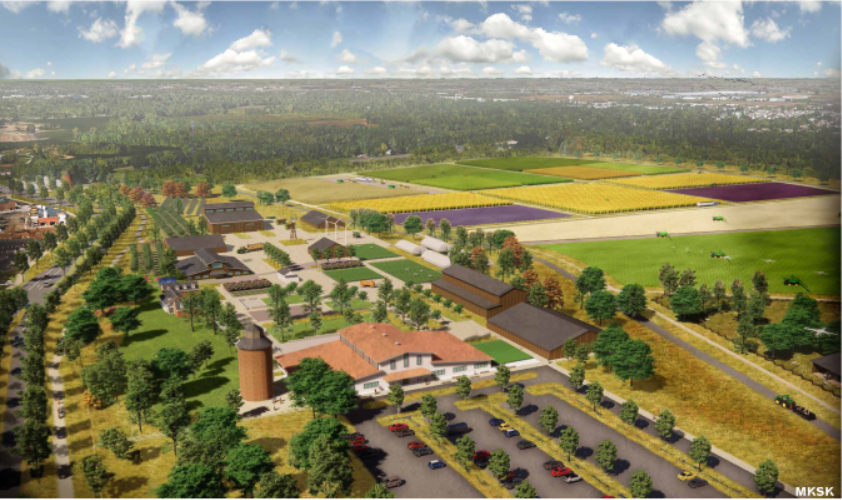Subscriber Benefit
As a subscriber you can listen to articles at work, in the car, or while you work out. Subscribe NowConner Prairie continues to tweak its plans for a 260-acre expansion on the west side of the White River in Carmel.
Representatives for the outdoor living-history museum in Fishers told the Carmel Plan Commission on Tuesday night that the project will involve developing 15% of the 260 acres of vacant land rather than 35% as the museum planned last year.
An eco lodge proposed for the southern end of the site near River Road would also be downsized to 70 rooms instead of 140 under the new plan.
Conner Prairie unveiled plans last August for $24 million in new capital projects that museum officials said would provide a “more complete and more inclusive” look at history and include expanding the museum west of the river into Carmel. The projects are to be funded in part with $15 million in private donations to the Prairie Pathways Campaign.
Officials for the museum did not say whether the price tag for the project would change with the adjusted plans.
The museum is seeking to rezone the property west of the White River, south of East 146th Street and east of River Road, to the Conner Prairie Planned Unit Development to allow uses it hopes to include in the expansion project.
Currently, Conner Prairie is only accessed from Allisonville Road in Fishers, but the expansion calls for a west-side access point at the River Road-Cherry Creek Boulevard roundabout.
Conner Prairie developed a master plan in 2018 to study the long-term future of its 1,046 acres of land and the 3.3 miles of the White River that run between it.
Now, Conner Prairie plans two zones on the west side of the river: the Food, Farm & Energy Experience District to the north and the Land, Water & Energy Innovation District to the south.
“The next 25 years will present many opportunities for museums to redefine themselves to remain relevant and be successful in a vastly changing world,” museum officials wrote in documents filed with the city. “Museums like Conner Prairie will need to adapt and reimagine how they engage visitors. To remain sustainable, museums must generate more earned income through dynamic and user centric programming models.”

The Food, Farm & Energy Experience District would be bounded by River Road to the west, East 146th Street to the north and the White River to the east.
It would include multiple buildings and exhibits, Eli Lilly’s farm and a modern farm, a solar field, trails, woodland, prairie, wetlands, a pedestrian bridge and parking. Visitors to the Food, Farm & Energy Experience District would need a ticket to enter.
The Land, Water & Energy Innovation District would be to the south between River Road and the White River.
It would include the White River Education and Ecology Center, an innovation center with up to 110,000 square feet of office space, the 70-room eco lodge, cabins, a farm-to-table restaurant that could be as small as 5,000 square feet or as large as 20,000 square feet, commercial buildings and a trail that would connect to River Road.
Aaron Kowalski, a senior associate with the Indianapolis office of landscape architecture firm MKSK, told the plan commission that Conner Prairie plans to continue refining the plan this summer.
“We’ve increased the amount of open space area,” Kowalski said. “We understand the value and importance of preserving this land and really treating this land in a way that exemplifies the ability to create a really special place here.”
Office space in the innovation center would be aimed at not-for-profits and “low-impact consulting firms,” according to Kowalski.
Ken Alexander, who also represented Conner Prairie at the meeting, told the plan commission that an Indiana company has expressed interest in relocating its headquarters to the innovation center.
Plan Commission members expressed concerns about potential impacts on nearby residential areas, the planned location of the eco lodge and cabins, and parking. Residents who live in nearby communities in Carmel have also voiced worries about increased traffic in the area, particularly near Prairie Trace Elementary School.
“I think it’s a phenomenal project. It’s going to be great for the community, but it’s got to be massaged so it works for the direct neighbors of the area. But, if done properly, it’ll be a phenomenal asset for all of us,” Plan Commission member Leo Dierckman said.
Carmel Clay Parks & Recreation is also planning to begin construction this summer or fall to extend the White River Greenway on land owned by Conner Prairie on the west side of the river. The museum granted an easement to the parks department to construct the trail extension.
The Carmel Plan Commission will continue discussing Conner Prairie’s expansion plans at a future meeting. The museum’s plans will need to be approved by the Plan Commission and City Council before construction can begin.
Please enable JavaScript to view this content.


Think big and be bold with this unique opportunity.
An improvement, but office use west of should not be allowed unless it pays full real estate taxes without TIF or real estate abatement. CP is not for profit but they are profiting from this. Otherwise the residential property owners will have to pay for the marginal costs to the community
That’s a lot of office space, especially considering the substantial vacancy rates area-wide.